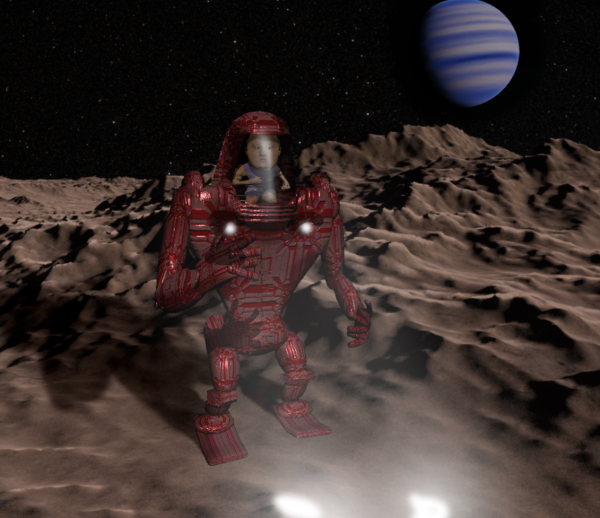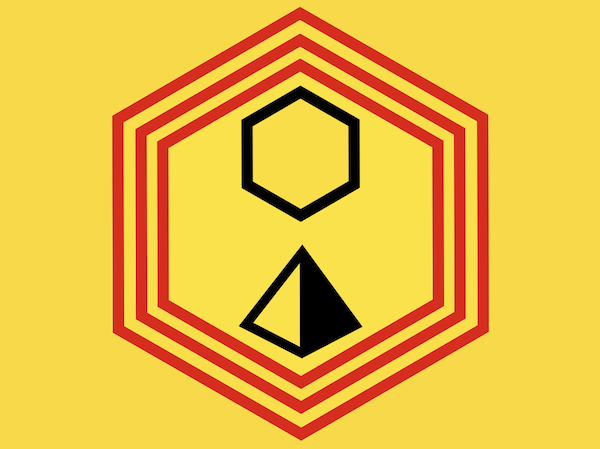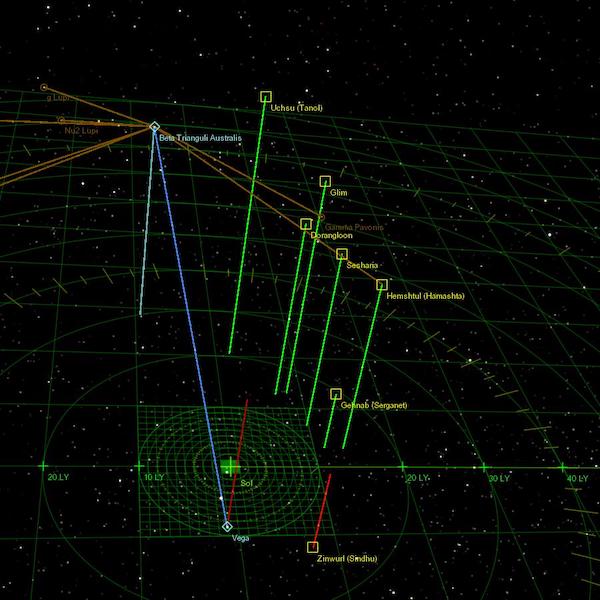BY LETTER
Doran Empire
Early interstellar empire, originally populated by a clade of short stature nearbaselines | |
 Image from Steve Bowers | |
| Members of the Clade Doran are small humanoids with normal-sized human heads. They are capable of moving around easily on low gravity worlds and moons, but find their small limbs a handicap on heavier worlds or when they need to walk longer distances. For this reason they habitually wear massive cybersuits; some with quite utilitarian aspects and others with more aesthetic designs. | |
A broad-wavelength scan of the direction from which the shot came identified the culprits; two Doran hitmen, dressed in their sharp suits which packed lots of surprises. The long legs of these suits hid advanced stilt-boots which allowed the dwarfish Dorans to move blindingly fast; the suits also used efficient chameleon-tech to make the hitmen difficult to see. Only by comparing a wide range of wavelengths could Muligan see them at all. Someone was upending a table to use as a shield against the projectiles fired by the attackers; this table was rapidly disintegrating under the well-targeted bullets. Muligan attempted to deploy the gun in his artificial left wrist, but the hit he had taken seemed to have affected his arm control; it hung uselessly by his side. He commandeered his human left arm and attempted to access a handgun concealed in his abdomen area, but the access hatch was distorted and wouldn't open fully. Only one option left, then; he flipped onto his back, and pointed his artificial left leg at the intruders. There's a gun in my boot, he thought — no time to unholster it, so he aimed his whole leg (using sensors in his toes) at one of the hitmen, who exploded in a shower of sparks.The Doran Empire was a minor interstellar polity that emerged during the late First Federation, a period which also saw the rise of many of similar interstellar polities, such as the Penglai Evolution, the Virginis Combine, the Hildago Emergent Order, and the Ruham Pact. Although its size and influence were nothing exceptional, it is notable for being the longest lived, surviving for over 2,000 years, long after its contemporaries were gone. The Doran Empire's cultural legacy lives on primarily in the Deeper Covenant.
From the floor he could see Mimosa flying overhead, aiming some tiny weapon at the other hitman; an even larger shower of sparks erupted as she found her target. Both sharp-suited Dorans crumpled to the floor, as Muligan awkwardly scrambled to his feet. Much to his surprise the hitmen both recovered quickly, despite their suits being in sparkling adamantine tatters. They darted out of the door-flap and disappeared.... -Head of the Herd
Background
Clade Doran emerged in the Interplanetary Age of Solsys. Named after their lead creator, Elishua Doran of Miranda Orbital, they were designed to have smaller bodies to reduce mass and life-support requirements, although their heads were the same size as most other contemporary human clades. Their small frame was well adapted to low gravity and microgravity environments, but they often used a range of robotic bodies, vehicles, and mechanical exoskeletons for more demanding tasks or for transportation in higher gravity environments.After the Great Expulsion from Earth, many Dorans from the asteroid Toutatis took advantage of GAIA's assistance and joined the Diaspora to the stars. Using antimatter gifted by GAIA, they left in an amat-fusion vessel in 629 and established a colony on Dorranok, a small planet orbiting Gliese 877, which they called Dorangloon. During the First Federation, these people became known as the Diaspora Dorans.
History
The Empire was born at Dorangloon in 1724, when the Dorans began to expand to two of the neighboring, unclaimed stars (Sesharia in 1602, and Glim in 1711). As Dorangloon had not seen much immigration throughout the Early and Middle Federation periods, the Doran Empire started out with very little diversity clade-wise, most of its inhabitants sharing virtually the same mental architecture, and its culture came to be described by many visitors as xenophobic.Early expansion was limited by the fact that all other nearby stars had already been claimed, and attempts at settling these systems ended with its colonies becoming aligned with the system itself rather than the Doran Empire. A notable example was Tanol, which, even though the colony was established decades before the competing colony mission from Mfunu (Zeta Trianguli Australis) arrived, still defected. In the end, the Dorans begrudgingly settled for accepting new members willing to join them. Most polities that joined them were culturally dominated by descendants of members of the Doran clade that remained in Solsys and later expanded to the stars during the First Federation, although the conservatism of the Empire meant many of them didn't stay for long.
The early third millennium saw more immigration into the Empire. These were chiefly people from nearby systems like Calendar, Aristotle, and Hamashta - all far more cosmopolitan than the Doran Empire. At first this resulted in conflicts and a number of questionable actions taken against the immigrants which resulted in souring relations between the empire and its neighbors, but over time interactions between the two groups gradually caused the Doran cultures to be more open to morphological and cognitive differences and freedoms.
At its greatest physical extent in the 3000s, the polity controlled five star systems: Dorangloon, Sesharia, Serganet, Hamashta, and Sindhu, and had some presence in a small number of systems scattered across the fledgling Nexus. By that point, the Empire's population had become cosmopolitan, and the original Doran clade had long diversified into thousands of major forms, some hardly recognizable as a descendant of Doran morphology, living alongside many other forms of sophonts.
Over its two thousand year-long existence, the Doran Empire contacted, and at times were in conflict with, the Deeper Covenant, the First Federation, the Eridanus League, the various megacorps of the NoCoZo, the Tahmetian Crusaders, and other polities and entities in its general vicinity. It was repeatedly attacked during the Age of Consolidation, causing it to begin losing members, and eventually the interstellar polity dissolved in 3868.
The flag of the Doran Empire |
 Image from Alex Mulvey |
Politics
The Doran Empire was notable during its time as a rare example of a constitutional monarchy, which it inherited from the preceding colony government. While real power was vested in a congress of democratic representatives, later heavily aided by transapient advisors, the ceremonial head of the Doran state was the Emperor or Empress. The Doran monarch was a figurehead and a person who had rendered exemplary service to the empire. Upon their coronation, they were implanted with the Crown of Doran, a ceremonial external neural interface that burrowed fibers through the skull into the brain. Via this method the artefact grafted personality traits taken from the original Elishua Doran, ensuring traditional values were maintained. Early Doran monarchs refrained from life extension; upon death, their heir was a backup of themselves made at their original coronation. These fork-monarchs gained another number to their name, and diverged over time. The intent was for each to learn from their previous versions. A reform made in the 2500s permitted monarchs to use life extension, but serve a set term of 30 years, unless abdicated or recalled by congress. Records state that the first person so honored was Zander vin Haward.As the Doran Empire grew to encompass more systems the monarchy, ceremonial as the position was, became increasingly unpopular outside of the home system. For several decades abolition of the monarchy was debated, but eventually the empire settled on a compromise. The Crown of Doran was duplicated into several lesser Crowns, one fabricated in each member system outside of the capital. In these systems local citizens were awarded the rank of Duke and shared a similar, local role as the monarch. They too received copies of the simms of past monarchs to act as advisors, and while the Dukes were practically independent due to the light speed delay between systems, the recordings and the Crown's conditioning ensured political parity.
 Image from Steve Bowers | |
| Dorranok TransCentral City. Dorannok is a small world covered in domed habitats, like many other Doran worlds. | |
Culture
Clade conservatismThe two most notable features of the early Doran Empire were, according to many Federation Era visitors, the lack of diversity in morphology and cognitive architecture among the population, and the prevalence of the social pressure to maintain this uniformity. These factors influenced nearly every other aspect of their culture - the conservative Doran clade was seen as the symbol of the polity and praised by Dorankuulism, the dominant religion, as holy. Modification of their body plan was shunned, and so on. The side effect of these beliefs was xenophobia - the locals were often wary of visitors belonging to non-Doran clades or of sufficiently modified versions of the Doran clade. Unlike how the media in other systems often portrayed them however, most citizens of the Doran Empire were not openly hostile to visitors.
A popular misconception is that this was always the state of things in Dorangloon, even before the founding of the Doran Empire. However, the strive for morphological and psychological uniformity only developed during the late First Federation, coinciding with the founding of the interstellar polity. It was apparently popularized by several mid-Federation Doran sociologists predicting the imminent decline of the First Federation as a result of overdiversification - and the drive for uniformity arose as a logical conclusion of this view.
Language
The Dorannok language - Dorannoskol - developed from the Toutatis variant of Doranskol, a constructed clade identity language that incorporated elements from several old Earth languages such as German, Swedish, and Arabic. It eventually accrued aspects of languages used in neighboring star systems, but retained a high degree of mutual intelligibility with many other Federation Era Doran languages until the end of the second millennium.
By the latter half of the third millennium, the original Dorannok language was largely a dead language, its decline sparked and hastened by both the shifting culture and the adoption of highly capable translation tech. By 3000, it was only spoken by a small number of Dorans and an even smaller number of sophonts from other groups within the Empire, but continued to be used by the imperial institution at various formal occasions, including the naming of new locations.
Arts and Entertainment
One way that the Doran Empire's clade conservatism manifested was through its arts and entertainment industries. Doran art and media can be described as inward-looking, often emphasizing the greatness of the clade's physical and psychological morphology. Visual arts and virch-dramas held the Doran form as the beauty standard to be achieved, with emphasis on specific characteristics depending on the location and time. The Hetraub games were a popular pastime which was believed to demonstrate Doran adaptability, ingenuity and teamwork. The games consisted of the design of robotic bodies and vehicles, which would then be operated by an ace pilot during sports competitions, divided by activity and environment. The Hetraub games had a practical side as well, as developers sometimes discovered ways to improve on suit technologies and sometimes even developed new models from scratch.
Eventually, due to the increased cultural influence of the neighboring polities and non-Doran immigrants, the Doran Art and Entertainment industries experienced a shift. Non-Doran sophonts began to participate in the artistic and entertainment endeavors, causing the focus to shift from glorifying a specific morphology to glorifying the Doran Empire and its culture. New modes of artistic expression, such as transapient Perfect Art, appeared and grew popular as the result of a renaissance event during the later phases of the transition to a more cosmopolitan culture.
Religion
Until the Age of Expansion, the Doran Empire was dominated by Dorankuulism, a non-dogmatic ethno-centric monotheism some have compared to certain forms of Old Earth Judaism. Dorankuulism acknowledged a single creator God that, while normally aloof from the affairs of the physical universe, had a special relationship with the Doran clade. The religion arose in tandem with the emergence of clade conservatism, but outlasted it; the increasing clade diversity within the polity during the third millennium led to several reformation attempts of the religion, spawning a number of new denominations in the process.
Member systems
| Star | Distance from Dorangloon (light years) | Name | Period | Notes |
| Gliese 877 | 0 | Dorangloon | 1724 - 3855 | Birthplace and the capital of the Doran Empire |
| HD 223889 | 5.315 | Glim | 1729 - 2638 | . |
| Gliese 54 | 6.361 | Sesharia | 1730 - 3861 | . |
| GJ 4102 | 14.432 | Uchsu (Tanol) | 1977 - 2135 | . |
| Gliese 1 | 19.207 | Gehnab (Serganet) | 2735 - 3539 | . |
| p Eridani | 11.709 | Hemshtul (Hamashta) | 2811 - 3390 | . |
| EV Lacertae | 38.949 | Zinwurl (Sindhu) | 2859 - 3180 | . |
Related Articles
- Conver Ambi
- Dorangloon (Gliese 877)
- Eridanus League
- Glim (HD 223889)
- Hidalgo Emergent Order - Text by Anders Sandberg
Hidalgo Emergent Order was a very expansive tweak-cyborg clade/corp that flourished during the late Federation and Expansion ages, setting up asteroid-based societies in the region between Capella and Pollux and becoming an important regional superpower. Using aggressive in vitro techniques they cloned large populations, but were unable to prevent Conver Ambi from gaining a monopoly on vital nanodesign objects, giving them an ever stronger hold on the Order. Eventually most of the Order joined the Conver Ambi, with the exception of a number of habitats that committed collective suicide. - Sesharia
- Tahmetianity, The Tahmetian Crusades
Appears in Topics
Development Notes
Text by Updated by The Astronomer, MacGregor, Rakuen07, and Rynn 2021
Original article by Steve Bowers and M. Alan Kazlev
Initially published on 09 October 2001.
Original article by Steve Bowers and M. Alan Kazlev
Initially published on 09 October 2001.







